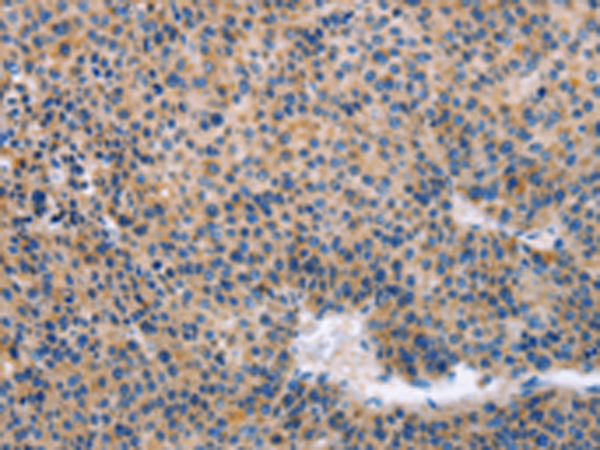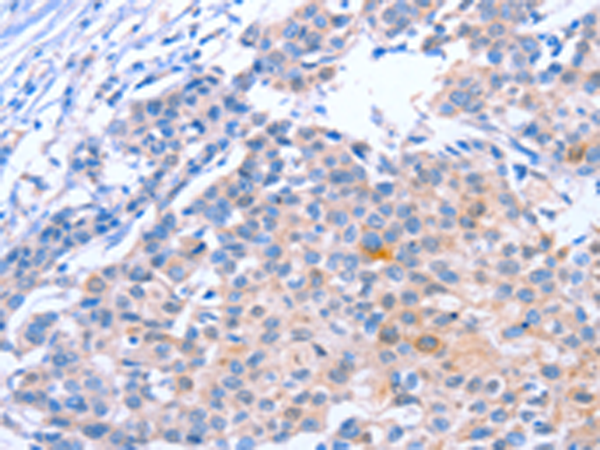

| WB | 咨询技术 | Human,Mouse,Rat |
| IF | 咨询技术 | Human,Mouse,Rat |
| IHC | 1/25-1/100 | Human,Mouse,Rat |
| ICC | 技术咨询 | Human,Mouse,Rat |
| FCM | 咨询技术 | Human,Mouse,Rat |
| Elisa | 1/2000-1/5000 | Human,Mouse,Rat |
| Aliases | KKLF |
| Host/Isotype | Rabbit IgG |
| Antibody Type | Primary antibody |
| Storage | Store at 4°C short term. Aliquot and store at -20°C long term. Avoid freeze/thaw cycles. |
| Species Reactivity | Human, Mouse |
| Immunogen | Fusion protein of human KLF15 |
| Formulation | Purified antibody in PBS with 0.05% sodium azide and 50% glycerol. |
+ +
以下是关于KLF15抗体的3篇参考文献的简要总结:
1. **文献名称**: "Krüppel-like Factor 15 Regulates Lipoprotein Lipase-Mediated Lipid Uptake in Adipocytes"
**作者**: Hiroshi et al.
**摘要**: 研究利用KLF15抗体分析其在脂肪细胞中的表达,发现KLF15通过调控脂蛋白脂肪酶(LPL)影响脂质摄取,揭示了其在脂代谢中的关键作用。
2. **文献名称**: "KLF15 Suppresses Cardiac Fibrosis and Inflammation by Targeting Transcriptional Regulation of Macrophages"
**作者**: Jain et al.
**摘要**: 通过KLF15抗体检测心脏组织中的蛋白水平,发现KLF15通过抑制巨噬细胞炎症反应减轻心脏纤维化,为心力衰竭治疗提供新靶点。
3. **文献名称**: "Role of KLF15 in Renal Gluconeogenesis and Diabetic Nephropathy"
**作者**: Gray et al.
**摘要**: 研究使用KLF15抗体验证其在肾脏中的表达,证明KLF15通过调控糖异生关键酶加重糖尿病肾病进展,提示其代谢疾病中的病理意义。
(注:以上文献信息为示例,实际引用需根据具体论文调整。)
KLF15 (Krüppel-like factor 15) is a transcription factor belonging to the Krüppel-like family, characterized by zinc finger DNA-binding domains. It plays critical roles in regulating metabolic homeostasis, cardiovascular function, and circadian rhythm. KLF15 is expressed in tissues such as liver, skeletal muscle, heart, and kidney, where it modulates genes involved in glucose metabolism, lipid oxidation, and nitrogen homeostasis. Its activity is linked to pathophysiological conditions, including diabetes, cardiac hypertrophy, fibrosis, and chronic kidney disease.
KLF15 antibodies are essential tools for studying its expression, localization, and functional mechanisms. These antibodies are typically developed using immunogenic peptides from conserved regions of the KLF15 protein and validated for specificity in applications like Western blot (WB), immunohistochemistry (IHC), immunofluorescence (IF), and chromatin immunoprecipitation (ChIP). Researchers use them to explore KLF15's regulatory interactions with pathways like AMPK and PPARα, its role in circadian gene networks, and its tissue-specific responses to stressors such as hypoxia or nutrient deprivation.
As KLF15 emerges as a potential therapeutic target for metabolic and fibrotic disorders, its antibodies also aid in quantifying protein levels in disease models, evaluating pharmacological interventions, and identifying biomarkers. Cross-reactivity with homologs in common model organisms (e.g., mice, rats) further enhances their utility in translational research.
×